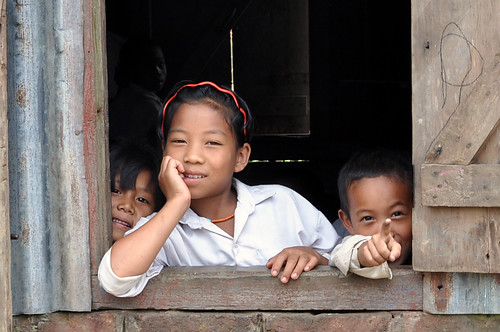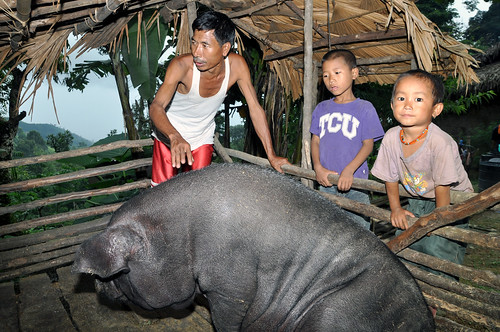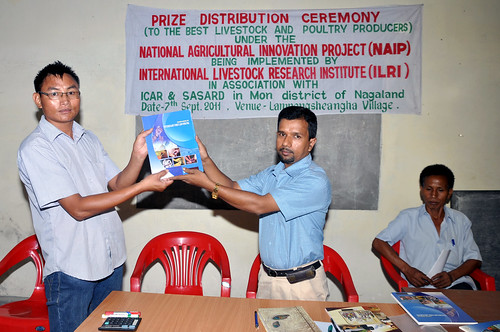Children of a smallholder pig-farming household in Mon District, Nagaland, in the far northeastern corner of (tribal) India, which is participating in an ILRI project to help the rural poor enhance their production of pigs and pork (photo credit: ILRI/Ram Deka).
A new set of training manuals for pig farmers is now available. The manuals inform poor rural pig farmers in developing countries how to ‘intensify’ their production, using lessons gathered from a research-for-development project in India. Among other recommendations, the manuals offer ways of improving smallholder pig farming, including basic veterinary care, and pork production and marketing.
‘These manuals are the result of an analysis of the main gaps in small-scale pig production in India,’ said Rameswar Deka, a scientist from the International Livestock Research Institute (ILRI) based in Guwahati, in northeastern India. ‘They are a response to farmer needs and offer a reference for best practices in managing small-scale pig systems.’
The manuals are a result of a project called ‘Livelihood Improvement and Empowerment of Rural Poor through Sustainable Farming Systems in Northeast India’. The five-year project, in India’s Assam and Nagaland states, was started in 2007 with funding from the Government of India, the International Fund for Agricultural Development (IFAD), ILRI and the World Bank.
Raising pigs is a particularly important livelihood for smallholders in northeast India, where hilly terrain, poor roads and widespread poverty hamper crop cultivation. ‘Crop farming alone cannot meet the needs of families in these areas and many rely on livestock–mostly pigs and chickens–to supply much needed nutrition and income,’ said Deka.
The livelihood improvement project is working with farmers to develop pig production in particular because the region has a history of pig rearing and because keeping pigs requires minimal investments at the outset. Pig production is also easily intensified using locally available resources.
There are three well-illustrated manuals. Smallholders’ pig management offers a detailed look at pig systems in India, including features of common breeds, how to care and manage piglets, the reproductive cycle of pigs, breeding methods and how to cultivate feed-food crops. Veterinary first aid for pig offers information on organisms that cause common pig diseases, how to identify them and basic ways of controlling their spread. Hygienic pork production and marketing details how to hygienically process pork, follow slaughterhouse and meat inspection procedures and how to pack and preserve pork for sale.
ILRI scientist Ram Deka (middle) distributes training manuals to Livestock Service Providers participating in an ILRI pig production project in the state of Nagaland, in northeast India, 2011 (photo credit: ILRI).
The manuals provide easy-to-apply principles in improving pig management, feeding, and care to enhance yields. Farmers in areas where the project is implemented say the manuals are helping them to increase their production. Project staff have set up systems for collecting feedback from farmers and trainers so as to improve future editions of the manuals.
‘We hope these manuals will serve other countries as well,’ said Iain Wright, ILRI’s former representative in Asia. ‘This information can be adapted to make relevant training tools for smallholder pig farmers in other areas of the world where small-scale pig production systems are growing rapidly.’
Download manuals:
Training manual on smallholders’ pig management
https://cgspace.cgiar.org/handle/10568/12533
Training manual on veterinary first aid for pig
https://cgspace.cgiar.org/handle/10568/12534
Training manual on hygienic pork production and marketing



